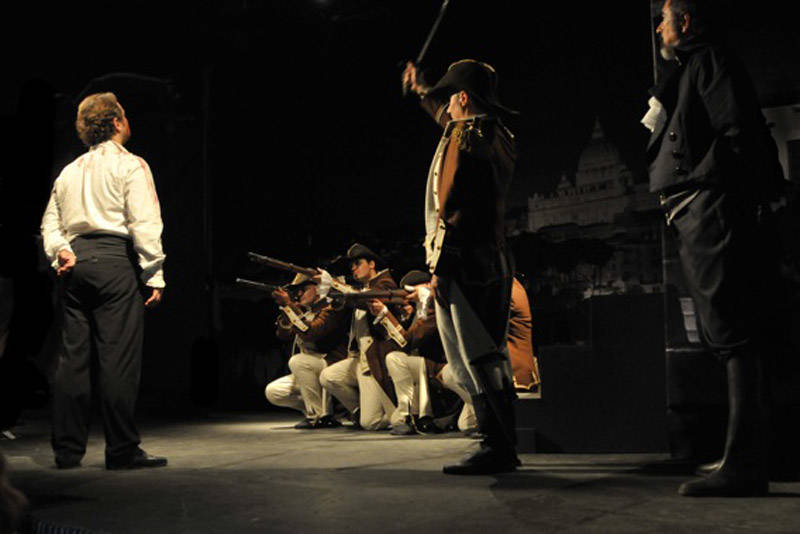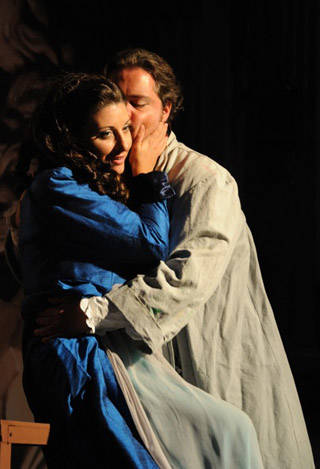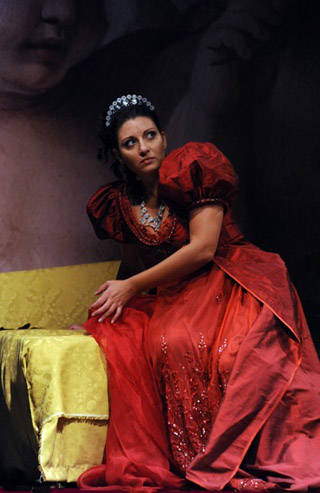Stylish Grand Opera for Summertime Umbria
In summertime in Umbria, there may be no cotton, but the livin’ is easy. The setting: on a balmy evening a full moon illuminates a medieval stone church in a tiny hillside town dedicated – as churches tend to be here in Umbria, the green heart of Italy – to the gentle Saint Francis. In a garden to one side of the church, 350 chairs face a stage that has been built and rebuilt twenty-nine times for an annual outdoor music festival, culminating this August with four stylish, sold-out performances of Puccini’s Tosca.
The rapturous musical heart of Italy, Umbria boasts over twenty annual festivals in which music is the centerpiece, from the renowned Spoleto Festival created by the late composer Gian Carlo Menotti to Umbria Jazz and the Classical Music Foundation concert series in Perugia. All these attract famous performers from the world over, and have considerable means behind them. But what kites the serendipitous scene at Preggio – what brings the hamlet’s 29th festival a step beyond the merely charming - is the quality of the production, which fuses high-tech sound with the extraordinarily capable local Umbrian talent and international performers, directors and patrons. And it attracts an international audience – largely vacationers in Umbria and Tuscany.
Starring in the performance, directed by Father Francesco Bastianoni, were two Perugia natives, the beautiful and talented Chiara Giudice as Tosca and the appropriately evil-looking baritone Giulio Boschetti as the wicked, womanizing police chief Scarpia. Sebastian Ferrada Garramon – a tenor with powerful voice and equally powerful stage presence – was the artist Tosca loves, Cavaradossi. Born in Uruguay in 1978, Ferrada Garramon studied and performed in Argentina and Chile. Since 2008, when he moved to Milan, he has studied voice at the Academy of the Teatro alla Scala and at the Accademia Internazionale della Musica.
Director Antonello Madau Diaz, another native of Perugia, is a veteran with countless La Scala productions under his belt, and has directed productions for the Arena of Verona and, in the U.S., for the Philadelphia and Chicago Symphony Orchestras. Also busy with films (including with Fellini), Madau Diaz was art director for the famous RAI TV filming of Tosca in the actual places where Puccini had envisioned the action – the Church of Sant’Andrea della Valle for Act I, the piano nobile of Michelangelo’s Palazzo Farnese for Act II and the ramparts of Castel Sant’Angelo for Act III.
So how do you bring an orchestra to a stage on a medieval hillside? Enter high tech Japan, whose Musical Academy of the Showa University generously donated to the Festival two Electone Model El-90 digital synthesizers. A 21st century Hammond organ, they reproduce, with stunning accuracy, a full orchestra sound, when played – as they were – by two competent young Japanese women, Kana Sasaki and Yuka Chiba, each following the complete musical score, no mean feat. The conductor, Bastianoni, is president of the Preggio Festival, and a trained musician who subsequently entered the priesthood and today serves as the parish priest for Preggio. And behind the scenes were dozens local English, Italian and American stage hands, organizers and patrons, among the latter American patron Bruce Wolfe and Italian patrons Marco and Maria Teresa Stoppoloni.
I asked the tenor, Sebastian, what set this opera production apart from others he has seen. His answer was simple: “It isn’t a cheap production—it’s the real thing.” And so it was.
Those who do not want to wait for next summer’s Preggio Music Festival can take advantage, this September, of the offering in Spoleto of another Puccini opera, Madama Butterfly, to be conducted by Caro Palleschi and directed by Andrea Stanisci, for six performances, Sept. 20-25, in the Teatro Nuovo. Coinciding with the wine harvest in Umbria, a night at the opera is a fine excuse for an early autumn vacation.





































i-Italy
Facebook
Google+
This work may not be reproduced, in whole or in part, without prior written permission.
Questo lavoro non può essere riprodotto, in tutto o in parte, senza permesso scritto.